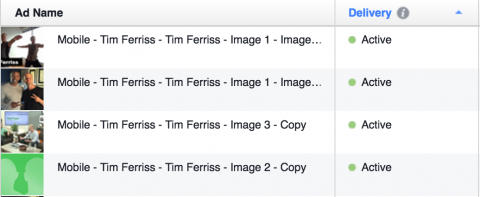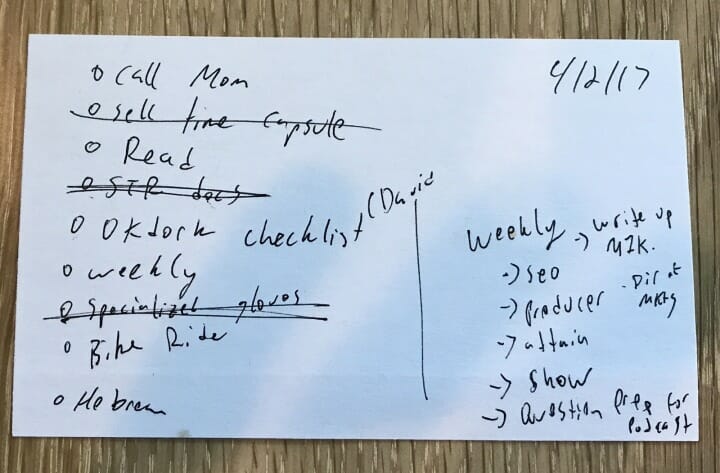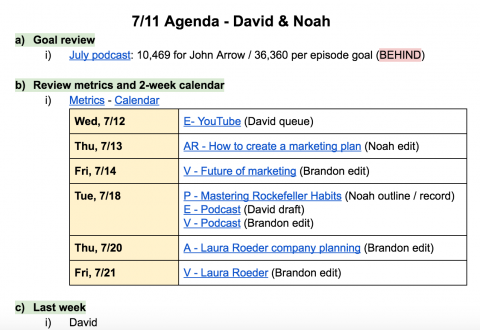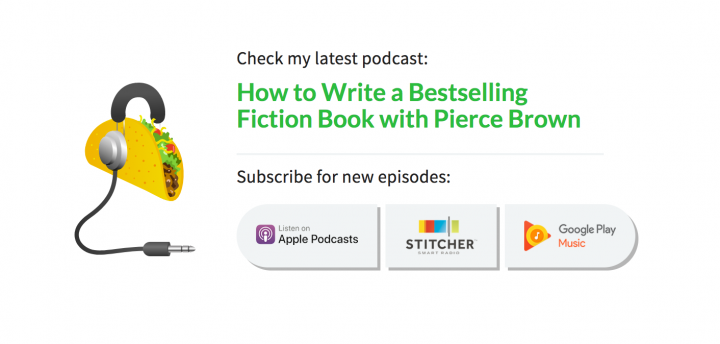I spent over $100,000 at U.C. Berkeley to get my undergraduate business degree.
Here’s the crazy part. I’ve used VERY little I learned from college in my marketing career.
Most of my experience creating a marketing plan and developing marketing strategies has come from…
- Being employee #30 at Facebook (and then getting fired)
- Growing Mint.com from 0 to 1 million users as the Director of Marketing
- Creating an 8-figure business
It was all B.S. The best training I’ve received happened on the job.
Instead of just talking theory — like you learn at college — I’m going to show you the EXACT marketing plan components I used to grow Sumo to an 8-figure business.
6 Steps to Creating an Epic Marketing Plan
- Validate your idea
- Pick an objective for your marketing
- Research the customer and where they go online / offline
- Model your objective in a spreadsheet
- Weekly and monthly reviews
- Adjust the sails if needed
Step 1: Validate your idea
The first, and most important, step of any marketing plan is to ensure you HAVE SOMETHING PEOPLE WANT.
The best marketing in the world won’t save a shitty product.
No amount of marketing will help a shitty product.
— noah kagan (@noahkagan) March 30, 2015
Marketing too early is one of the biggest pitfalls I see entrepreneurs run into.
For example, it’s so easy to launch a product, see a few people sign up, and get excited.
But what most entrepreneurs don’t see (or choose to ignore) is how people are using the product.
Getting signups is the easy part.
But having a product people want, solves a problem, and grows over time? That’s the hard part.
If your product doesn’t have the right fit with your target market yet, you’re wasting your time (and money) marketing.
Step 2: Pick an objective for your marketing
“Starting with the destination and then planning the route is much easier.”
Your objective is the focal point for any marketing plan.
Before you start thinking about specific tactics or growth experiments, you need to have your objective set in stone.
For example, here’s a breakdown of some of our previous Sumo goals:
- 2012 – AppSumo to 500k email subscribers
- 2014 – 1 billion visitors across Sumo
- 2015 – $1 million ARR (annual recurring revenue)
- 2016 – $5 million ARR 2017
Do you see what all these goals have in common? They’re:
- Simple
- Clear
One common mistake I see from entrepreneurs and business owners during the marketing plan steps is wanting “more.” More revenue, more traffic, more downloads.
But, most entrepreneurs never quantify their goals.
Don’t aim for “more” without any clear plan. Instead, set specific goals.
Right now, my #1 objective with my site is to grow my podcast, Noah Kagan Presents, to 100,000 downloads per episode by the end of 2017.
Every morning when I wake up, I know my mission: Get more people to listen to my podcast.
Every task I do is focused on getting closer to the goal.
What’s the most important focus for your business right now?
Answering that question is a great way to figure out your #1 objective.
To start thinking about your business’s #1 objective, here are a few examples:
- Revenue growth: Hit $10,000 MRR
- Email list: Get 100,000 email subscribers
- App downloads: 1 million
- Podcast downloads: 100,000 per episode
- Blog traffic: 30,000 visits per month
Have one clear goal for your business. This makes the other marketing plan steps much easier. Simplify your focus.
Step 3: Define your customer
If you don’t identify your target customer, you’re shooting in the dark and hoping to strike it lucky. That’s not a marketing plan, that’s a pipe dream.
In any marketing plan, you need clearly defined target customers so you know EXACTLY who you’re trying to reach at all times.
My best advice is to work backward and define two things:
A) WHO is your customer?
Here’s what I know about my customers at AppSumo andSumo:
- Entrepreneur-focused, aka want to start a business
- College graduates with professional jobs (likely into marketing)
- Read self-improvement books, aren’t boring, and like eating tacos 🌮
The MORE you define and narrow your customer, the better.
B) WHERE is your customer?
Once you know your customer’s interests, you can start looking where to find them.
For example, I know my customers love Tim Ferriss. So, I advertise to fans of Tim Ferriss’ brand on Facebook:

| BONUS: Get my MEGA-guide on how to start advertising on Facebook |
It’s not always easy to figure out where you customers are hanging out. Here are a few tactics to help.
Survey your current customers
Take your list of current customers or email subscribers, and send them an email asking their favorite blogs, Facebook groups, and people to follow on Twitter.
Compile your answers and see what sites and communities pop up regularly.
This helps you paint a picture of your audience, their habits, and where you can reach them.
Check your analytics
You can see where your site visitors come from using Google Analytics.
To get started, check out Google Analytics → Acquisition → All Traffic → Referrals.
Make sure to give yourself a long(ish) time range: 30 to 90-days will show you a good cross-section of referral traffic.
Other websites to use for finding customers
Here are my favorite places to find where customers hide out:
- Reddit: There’s a subreddit for almost any topic you can imagine. Search subreddits by keywords and take a look at popular topics / discussions in your niche.
- Twitter search: Head to Twitter search, type in some keywords related to your business, and check out who’s talking about those topics.
- Instagram: Instagram isn’t all selfie pics. It’s also a helpful platform to research your target market. Plus, you can search for hashtags and influencers in your niche to discover what your prospects and customers are talking about.
Once you find out WHO and WHERE your customers are, it’s much easier to develop a marketing plan.
Step 4: Model your objective in a spreadsheet
Here’s my favorite marketing plan example: My quant based marketing approach helped me grow Mint.com from zero to 1 million users in just six months.

| BONUS: Get the quant based marketing spreadsheet for yourself |
It worked so well for Mint, I now use quant based marketing for EVERY new product, service, or company I launch.
Where should you begin with your own business?
With quant based marketing, you work backwards from your goal to figure out the exact tactics that’ll help you achieve it.
Here’s how I’ve modeled my goal of 100,000 podcast listens per episode:

My goal of 100,000 downloads is clearly highlighted. Everything I’m planning to do is focused on hitting 100k.
This spreadsheet also gives me tangible monthly target and growth numbers:
- July’s goal is 28,868 downloads
- August’s goal is 37,011 downloads
- September’s goal is 47,451 downloads
Knowing the numbers is an extremely helpful way to stay focused on the #1 objective. I can say “no” to a lot of ideas that might be fun to try, but don’t bring results.
When marketing channels work, do more. When they don’t, stop.
Generally, you’ll need at least a month to see if a channel is promising or not.
Choosing growth tactics to test out
Knowing your goals is one thing, knowing EXACTLY how to achieve them is a different game altogether.
I’d recommend focusing on two specific areas for your marketing plan:
- Increasing your traffic
- improving your conversion rate
Choose to focus fully on EITHER traffic or conversion rate at a time.
Picking only one at a time allows you to have laser focus and increase your chance of success.
To prioritize, open up a new spreadsheet and create the below two columns:
- Potential Increase in Traffic / Conversion rate
- Potential Ease of Accomplishing
On a 1-5 scale, label each idea with how much you think it’ll boost traffic or increase your conversion rate and how easy it is to accomplish. This will be a subjective score, so don’t worry about it being perfect.
Rate “Ease of accomplishing” 1 through 5, with 5 being the easiest.
Then in a third column, combine the two numbers. This will help you prioritize tactics you feel will increase traffic or conversion rate, plus be easiest to implement.
To help you get started, here are some ideas to either help increase traffic or improve your conversion rate.
Pick whichever you think has the biggest growth potential for your idea or business.
Ideas to drive more traffic to your site
Typically, more traffic will lead to more sign-ups.
The important thing to focus on is NEW VISITORS. If you have Google Analytics on your site, you can easily find the % and figures for new vs. returning visitors:

Here are my favorite ways to drive new visitors and traffic to a site:
- Email marketing: I’ve found email marketing to be the ONLY consistent, reliable and scalable channel for growing a business. Is it a coincidence that Amazon, Uber, The New York Times, and every major online site asks for your email? Email marketing works.
- SEO: Search engine optimization is another reliable way to grow your traffic (but it takes time). Do some keyword research to discover what people in your niche are talking about. Create hyper-targeted content to drive traffic.
- Sweepstakes: Sweepstakes are one of my favorite ways to drive traffic. Round up some epic prizes, create a sweepstakes page… and promote the shit out of it
More ideas to drive more traffic:
- Write more guest posts
- Answer questions on Quora
- Increase advertising on Reddit
- Guest appear on a podcast
- Repost articles on social media (Medium is underrated)
- Edit and relaunch old content on your blog
This is just the tip of the iceberg. There are HUNDREDS of tactics to help you grow your traffic and improve your conversion rates. Get creative and list as many as possible.
Ideas to increase your conversion rate
Your conversion rate refers to the number of people who visit your site and take your desired action (download an ebook, sign-up for your newsletter, or something else).
Here’s a look at how to figure out your conversion rate:
- Total conversions are the number of people who did whatever you’ve defined as a conversion (signing up to your email list, purchasing a product, etc).
- Your conversion rate is your total conversions divided by the total number of visits
For example, 10,000 visits and 100 downloads would mean a conversion rate of 1%.
Right now, I know boosting my conversion rate means increasing the number of visitors who download and listen to Noah Kagan Presents.
I’m experimenting with a number of ways to do this, including a new podcast widget on my homepage:
Here are some ideas to help you increase your conversion rate:
- In-content CTAs: Show your readers what to do on every page on your site: Do you want them to read another post, share their email address, subscribe to your podcast? Make it clear.
- Add a Welcome Mat: Display a full-screen call-to-action that shows when visitors land on your site with Welcome Mat. Over 100,000 sites use this technique (including Tony Robbins).
- Test, Test, Test: Your “Sign Up” or “Buy” button could perform better depending on its size, location, copy, and even color. Test BIG changes to uncover quicker wins.
More ideas to increase conversion rate:
- Add an email pop-over to your site
- Create a free product as lead gen
- Add an email capture to your homepage
- Optimize your site for the mobile experience
- Add more email collection boxes throughout your site
Step 5: Daily targets and weekly reviews
Sometimes it can be hard to tell how you’re performing against your targets.
We’ve all been there, right? You put in all the hours under the sun and work your ass off, but then at the end of the quarter, you realize you’re still behind where you should be.
Want to know how to avoid this?
Break down your objective into smaller, more achievable chunks.
I didn’t just say “I want 100,000 downloads per episode on my podcast” and throw my hands up yelling thinking I’m done — I worked out what growth looks like each month.
Then, I check in daily and weekly to measure my marketing plan progress…
Daily
Every night I write a note card outlining what I want to achieve the next day.
Recently, I added to one of my cards “be interviewed on another podcast.”

Every task should nudge you closer to your goal.
Weekly
Every week you should be reviewing / updating your quant based marketing spreadsheet to see the results from your efforts. Then you can continue more of what’s working and eliminate the ineffective activities.
I also meet with one of the members of my team to discuss weekly progress towards the goal.

Checking in on the numbers weekly enables you to adjust your marketing plan as needed.
Step 6: Adjust the sails (if needed)
The 80/20 rule, or “Pareto Principle,” means roughly 80% of results come from 20% of causes.
This rule also applies in marketing:
- 80% of your time creating content — and 20% promoting it
- 80% of your time on the tactics you know work — and 20% experimenting
The hardest part of marketing is finding the tactics worth dedicating 80% of your time.
Often, too many people just follow what others do without much thought:
- “Content marketing works for Sumo, I’ll just do that”
- “I’ll start a YouTube channel like Casey Neistat”
- “I should post on social media because I heard it works great”
Test these tactics yourself.
You need to find the tactics that are right for your business — not just what’s the “hottest” marketing strategy on GrowthHackers this month.
Once you’ve used the quant based technique to prioritize your tactics, you’ll have a list of things to try. If something works, stick to it.
Here’s an example of caution…
At Sumo, content marketing has been a killer tactic for us.
But, instead of focusing just on content, we put our attention elsewhere because we heard online advertising was good. We wasted a ton of time and money on Google AdWords thinking it would eventually work. Ouch. 😭
When something doesn’t work, move on.
When something does works, do more of it.
There’s nothing wrong with experimenting and trying new channels — but you need to set time limits to stop if something isn’t working.
Sometimes, you’ll need to adjust the sails and rethink your marketing plan to stay on track to achieve your goals.
Remember, be patient. With these five steps you’ll create an amazing marketing plan:


29 responses to “How to Create a Marketing Plan: My 6 Step Process”
Hey Noah! I think in the following sentence: “Rate “Ease of accomplishing” 1 through 5, with 5 being the most difficult.” You got the numbers backwards (according to your quant based marketing article) and the 1 is supposed to be hard and 5 easy… Is that right?
First: tacos vs. burritos – why tacos? (I’m willing to be persuaded).
2nd: I’m considering a service business that transpirts wealthy customers who need scheduled visits (often 3x a week) to life sustaining appointments ie. dialysis, chemotherapy, etc. I’m thinking they will be on the senior end of the age spectrum. What would tactics be to find potential customers to survey?
The spreadsheet link doesn’t seem to be working????
A) WHO your customer is
For me: I know many of my readers want to start a business, are college graduates with professional jobs, potentially work in a marketing role, like self-improvement books, aren’t boring, and like eating tacos. Age wise they are 25-40. They tend to be (or want to be) geographically independent.
The EXACT description of who i am. Thnx for a great article.
Haha, same here! 😀 I’m a cofounder and a cmo in a self-development company.
Though a somewhat dated article this is still 100% relevant. Nice work.
Sharply said. I like this as a tight microcosm of what’s possible.
“It’s funny, I spent over $25,000+ to major at UC Berkeley”
90% of college is a complete waste of time. The remaining 10% is partying.
Great post. I liked the spreadsheet and your informative writing style. Thank you for sharing.
Thanks for the great information!
Awesome Piece.. I am going to follow it and this is a perfect piece of marketing plan. Thanks a zillion for so detailed work. Thank You
Today marks the end of 2014!
Did you hit your goal ?
Thanks for sharing this awesome plan. I will use it for my own plan.
Hi Noah, thanks for this post and great usable content!
One thing though, how do you measure people that are interested in you+your product but don’t want to give you their Email? I for one would rather subscribe to the feed and read in my Feedly or other aggregator. I am in the process of minimizing my inbox mercilessly and nevertheless am a loyal subscriber.
Thanks great advice!
After reading this I’m glad I was one of the 7% 😉 Will be back for more!
Awesome! Super excited to try out the Atlas! Thanks, guys!
You know everyone is saying they dont use anything they have learned in college in their jobs today. I wish someone would open a college where they would teach these skills that people actually use! I’d go back to school for that, or even to an online University. HMMM Idea?!?!
Hi Noah, it’s so interesting that I almost match all the description of your target reader – I am a college student who wants to start my own business, interested in marketing and like to read self-help books. I just started my own blog and am struggling in defining my target reader. Do you have any advice? Thanks, Alfred
Brilliant stuff. Good way to think of 80/20 – 80% of time on stuff that works and 20% trying something new.
Very informative and easy to comprehend the materials covered.
Where can we find part 1 ?
Noah, I am loving these posts so I thought I’d ask you a question that plagues me and almost every other self-pubbed author I know. I write romance novels. I sell moderately well, could always sell more though. I’m sold on the importance of newsletters but frankly, there isn’t a heck of a reason for readers to come to my site. I offer a free novella to people that like/friend me on Facebook and if they sign up for the newsletter they get a free full length book. I’m in the process of creating new content (a sort of new reader’s gift package) to sweeten the pot so to speak but how do you get people to invest (emotionally) when they are buying through a 3rd party? I can sell a ton on amazon but I don’t have access to those customers unless they come to my site and sign up. I put links to my website in all my books, got a pop up that asks them to sign up for the newsletter and tells them what they’ll get if they do. I feel like there is a link I’m missing. Suggestions?
Noah in tha house! 1.. 2.. 1.. 2.. check.. ha!
Thanks for the numbers lesson, that was tasty! Can’t wait for what’s to come.
Rock on
Noah, great advice about dividing your goal into smaller goals. I did crew in college and I used this method for the erg test. I would divide the distance into smaller parts and make sure I was pulling at the right power for each section to reach my time goal.
Hi Noah,
great post and thoroughly agree that working backwards from your objective brings insights that are often overlooked. I’ve used this approach with Clients whose eyes are opened for the first time about the resource and skill demands required to achieve the blind objectives that corporate planners have imposed.
I’m now really interested to read Pt 1but how/where do I find it?
Terry
GREAT stuff as always Noah. I’m in your 1K course, and I highly recommend it. I agree with the 80/20 unless you actually write for a living, and then I wonder if it’s the other way around. If you’re writing for a blog to drive traffic then what you’re saying makes sense.
One question I have is do you have a way of measuring the effectiveness of your content and adjusting it to be more effective with your existing subscribers who maybe a great source of new referrals?
Thanks again for a great course!
Christopher
I just launched a redesigned website yesterday, so this topic is very timely. I’m already working on ideas for conversion and traffic that I’ll implement this week. Thanks for sharing.
Love the spreadsheet and marketing tool kit! Simple, but easy to use.